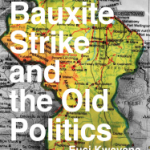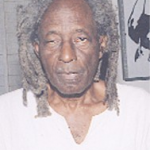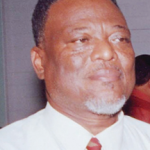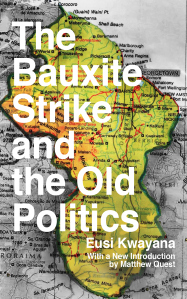Activity: Book launch (re-publication)
Co-ordinator: Moray House Trust
Date: Friday 8 February 2013
‘The Bauxite Strike and the Old Politics’, originally published in 1972, depicted the struggle between the bauxite workers of Linden, the Canadian owned aluminium plant and the administration of Forbes Burnham. It was republished in 2012 and a re-launch of the publication was organised by friends of Eusi Kwayana.
Mr Lincoln Lewis (General Secretary of the Guyana Trades Union), Sharma Solomon (Chairman of Region Ten) and Deputy Prime Minister Sam Hinds all contributed their analyses of events at the time and subsequently.
Video Clips:
1) A different kind of politician
You Tube Clip: http://youtu.be/9yvv_PpVc50
Eusi Kwayana, elder of Guyanese society, has had a career as a scribe, teacher and social activist greater in breadth and length than most others and rooted, primarily, ‘in the experiences of the people’. He has been a member of all three major political parties and has composed the theme song for each one. Estherine Adams whose post-graduate work was on the early years of Kwayana delivered this presentation.
2) Politics of control
You Tube Clip: http://youtu.be/3q9aMPMeL4I
Lincoln Lewis, General Secretary of the Guyana Trades Union, shared some thoughts on the relevance of Eusi Kwayana’s ‘The Bauxite Strike and the Old Politics’ at the launch of its re-publication.
3) Linden 2012
You Tube Clip: http://youtu.be/qBO9n9r_3qA
Sharma Solomon, Chairman of Region Ten, discussed certain similarities between the situation described in ‘The Bauxite Strike and the Old Politics’ and the events in Linden in 2012.
4) Sam Hinds remembers
You Tube Clip: http://youtu.be/t8exUw3Id54
Sam Hinds, Guyana’s Prime Minister, worked in Mackenzie for Demerara Bauxite Company (Demba), owned by Alcan during the late 1960s. He shared his memories of ASCRIA (African Society for Cultural Relations with Independent Africa), the RILA strike and the nationalisation of the bauxite industry.
Press Clipping 1:
Title: Eusi Kwayana: The Bauxite Strike and the Old Politics
Source: On Our Own Authority Publishers. 
Date: 14 June 2012
Eusi Kwayana is a Pan African and independent socialist activist, teacher and writer. He has been a colleague, critic, and mentor to Cheddi Jagan, Forbes Burnham, and Walter Rodney, who are often regarded as the triumvirate of major personalities that have shaped Guyana’s political history. His political analysis has anticipated direct democracy and workers self-management as synonymous with the spirit of Black autonomy and multiracialism among the Caribbean New Left. He is also the author (with Tchaiko Kwayana) of Scars of Bondage: A First Study of the Slave Colonial Experience of Africans in Guyana.
Originally published in 1972, Eusi Kwayana’s The Bauxite Strike and the Old Politics offered profound lessons for class struggle in a multiracial society. Many decades later, Kwayana’s work remains urgently relevant. A product of Guyana, and a classic of Caribbean radical history, The Bauxite Strike and the Old Politics examines the struggle of Afro-Guyanese mine workers in what was the soon-to-be nationalized bauxite industry, as they faced off against the racism and sexism of the Canadian-owned aluminum firm, ALCAN, the inert and ineffective bureaucracy of the Guyana Mine Workers’ Union (GMWU), and the hostility of Forbes Burnham’s government toward their self-organization and self-emancipation. Through these events, Burnham’s regime—which initially claimed to be a patron of global African solidarity, cultural renewal, and a cooperative society—began to reveal itself as a collaborator with the empire of capital, an oppressor of Black workers, and a promoter of racial insecurity in Guyana.
Kwayana’s work leads us to reconsider the nature of representative government and electoral politics. Black power, for Kwayana, began to transcend the notion of a Black ruling elite’s equal opportunity to enter the rules of hierarchy. Through engagement with Guyana’s bauxite workers, Black Power became synonymous with Black workers’ control.
This new edition of The Bauxite Strike and the Old Politics includes a new introduction by Matthew Quest, and an appendix of rare ASCRIA (African Society for Cultural Relations with Independent Africa) documents and writings by Kwayana, spanning this period of Guyanese history from 1972 to 1974. This new material documents Kwayana’s fight against government corruption, his participation in Guyana’s cooperative movement, and his facilitation, in 1973, of a multiracial rebellion of landless sugar workers.
Press Clipping 2:
Title: The Bauxite Strike and the Old Politics being relaunched tomorrow
Source: Stabroek News
Date: 7 February 2013

Friends of Eusi Kwayana are pleased to announce the republication and launch of his book The Bauxite Strike and the Old Politics at Moray House tomorrow.
“First published in 1972, the book gives a first-hand account of the events beginning with the retirement income life assurance fund (RILA) through the useful reproduction of newspaper editorials, articles, and pamphlets by the strikers’ organisation and ASCRIA whose local Chapter in Linden joined the workers in their struggles to secure and defend their rights,” a press release said.
It also said that the book is “a real time documentation of the cataclysmic events in 1971, the year in which the National Assembly passed the Bauxite Nationalisation Act with three MPs voting against nationalisation.” The Bauxite Strike and the Old Politics recounts the role of foreign exploiters of Guyana’s natural, non-renewable resources; the transformation and conduct of the PNC Government once it assumed the role of employer; the beating and jailing of workers by soldiers and their tear-gassing by police; the part played by then Leader of the Opposition Dr Cheddi Jagan; and the plight of ordinary workers betrayed by their own trade union.
The book also captures “in vivid and inspiring detail the power of self-organisation and the fearlessness of the workers, who were not prepared to accept a status quo in which they were second-class but were ready to take on the power of elite Georgetown as they struggled for emancipation. According to the release, Kwayana’s book also sheds light on the roots of the post-colonial crisis of governance worldwide and is a lesson against which to frame a response to recent developments in Linden. As the author has written recently, the story of the bauxite workers struggle in the 1970s is a challenge to those who choose to forget that 2012 was not the first time that Linden rose up against injustice from the state.
At tomorrow’s launch, there will be a panel discussion featuring Estherine Adams whose post-graduate work was on the early years of Kwayana, Sharma Solomon and Lincoln Lewis. There will also be an audio interview with Kwayana and Dr Nigel Westmaas moderated by Dr David Hinds.
The launching is set for 5.30pm.
Press Clipping 3
Title: The ten years before and the ten years after bauxite nationalization were uncharted, worrying times for those who lived it
Source: Stabroek News
Date: 16 February 2013

Dear Editor,
With respect to the presentation at Moray House of the 1972 book by Mr Eusi Kwayana entitled The Bauxite Strike and the Old Politics, at which I was present, please allow me to state my story with some elaboration in order to set the context and, hence, aid understanding of an historic time.
I accepted an invitation to attend this presentation, thinking that it might be known that I was in Mackenzie/Linden at the time, as I was. And, I did have some interaction with the RILA strike and Mr Eusi Kwayana, and could provide an additional view.
Meeting with Ascria – 1965
In 1965, I was one of a number of ‘summer students’ at Demba (the Demerara Bauxite Company – Alcan-owned), from which I had received a scholarship to attend the University of New Brunswick in Canada. Mr Arthur J. Seymour, then in the Community Relations Department, spoke to us summer students, telling us about some GCE, ‘O’ Level, evening classes being run at Wismar, over the river, by Ascria. I was one of a few who responded to the call for help, and might have been the only one who persevered until the end of the summer, teaching a class of ‘O’ Level economics.
Meeting with Ascria – 1970
I returned to Demba in June 1967, within about a month after my graduation. The Management Employment Officer remarked, “There is talk about pinching our property. It should be known that Sekou Toure pinched our property in Guinea, some years ago. I think that since then, he has managed one shipment of bauxite of 60,000 tons to Poland. We are hearing that he wants to ask us back. It should be known, also, that Australia is just now coming onto the market.” Prophetic words!
‘Guyanization’ of the staff was proceeding at some pace. In about September 1970, myself and other seemingly Afro-Guyanese members of staff received a somewhat abrasive letter inviting us to a meeting at which we could offer to help those who did not have the fortunate opportunities that we had. The letter was from Ascria, in Wismar, not then comprising of the older, milder men of the Ascria I knew in 1965, but a much younger, more aggressive bunch. I enquired about my ‘O’ Level economics class of 1965 and about a Ms Washington, and was told (by Odida Quamina, I think) that “the operation was successful but the patient had died.” Ms Washington (among others) had passed her ‘O’ Level Economics and had managed to gain employment at the prestigious Watooka Day School, departing from her school, on the Wismar shore, attended by the children of workers, for the school attended by children of the staff.
Essentially, we were being called upon to be teachers at an Ascria-run GCE ‘O’ Level evening college, to be held in the Wismar Hill Government school. It soon became evident that there was a contentious policy issue amongst members and executives. Some (not Odida Quamina, as I recall), held out that only blacks should be in the school, both teachers and students. The people in the area were 95%-plus black people, anyway. I argued against it – I could not participate if that policy was maintained, and to that end I put forward three good reasons:
i) it was wrong, heartless, and I would be uneasy about anyone growing up heartless about the needs of other human beings;
ii) an African youth passing by an Indian or Amerindian youth who could not attend, could already have a false feeling of winning and achieving, that could dull his application; and,
iii) I have some other ‘thing’ in me – clearly so in many of my friends and relatives; and, more than that, as I look at you, I see many of you who look like you have some other ‘thing’ in you, too – and, we might soon need a commissar for racial purity. I argued that whomsoever wanted to, let him or her attend, and let the black youth rise to any challenge presented by the performance of those others.
I judged that my participation was desired and, so, there was some sort of compromise understanding, but the issue remained a sensitive one over the next three months, approximately, with me spending some two to three hours on three or four nights per week, at the school.
Then, one evening, the officer maintaining the registers, threw them down on the table and declared, “I ain’t keeping no register with… [Indian] and… [Amerindian] inside.” We had to again meet and discuss. By then, there was a growing awareness and concern in the air about nationalization, a steadily more consuming distraction for us all. I took advantage of it and proposed that we should suspend classes until after nationalization had passed.
One of those aggressive young men, Odida Quamina, later pursued studies in Canada. When we met in Linden some time after he had become Dr Odida Quamina, I said to him, “You should stay on here and establish the college you wanted me to do.” He replied, “They say, like Walter, I have the beard and the doctorate – my prognosis wouldn’t be too good.” I met another, a Mr Bristol, when he was on a visit to Linden in the 1980s. He told me about how well-ensconced he then was in Guinea, and he seemed to be holding out that I could well move to that country, with him. In May 2012, while in Johannesburg, South Africa, for a meeting of ‘Africa and its Diaspora,’ I was to hear of him again from a small gathering of Guyanese in the Johannesburg area – he was in Bloemfontein!
There never was any doubt that there was, and continues to be, great potential in Linden, but people often felt frustrated and angry, striking out against perceived wrongs and constraints.
Organizational charts
About two months later, one or two young men from Ascria met me (outside of the Adams Crescent Hotel, I think) and asked me if I thought that I could run the alumina plant. I answered, “maybe,” and I enquired why. They claimed that Eusi told them that Forbes had promised that, on the nationalization of Demba, Eusi and the Ascria would be put to run the new bauxite company. They had been asked by Eusi to prepare the new after-nationalization organizational charts, with posts and names. They showed me some of their very preliminary proposals.
By that time, in early 1971, there might have been fifty to sixty Guyanese out of a staff of about two hundred, with a number of them having about ten years’ service, and attaining the midway level of department superintendent. I thought that the Guyanese staff could do a better job at developing a post-nationalization organizational chart. (Yes I was/am aware of the possible questions of my class bias). On speaking with other members of staff, most were opposed, in varying degrees, to, as they say, “meddling in things,” although many were wary of any leading role for Eusi and Ascria. However, my good friend, Jim Blackman, joined with me and Clarence London, very reluctantly. We benefited also from the ideas of Wesley B N Arthur. I will admit that this initiative was very controversial. Jim and I and, later, Clarence, met with Eusi on a number of occasions at his GMC office at the south end of the Sprostons, later GNEC, complex, on Lombard and Sussex Streets, and in our various homes, in Mackenzie.
Rila Pension Fund.
Nationalization was popular. The vision of owning the commanding heights of the economy, in our newly-independent country, was irresistible – the problems lay in the working out. One of the issues of the approaching nationalization was what to do with the Demba employees’ pensions in the Alcan group pension-fund – Rila. Those who were ‘locked in’ − ten or more years of membership − could receive, at their retirement age, a pension, directly from Rila, based on their own, and Demba’s, contribution. Those who were not ‘locked in’ would receive a refund of their contribution only. However, if a sufficient majority approved, the total package (both Demba and workers’ contribution, in regard to everyone) could be transferred to a new pension scheme to be set up in Guyana.
The government of the day, advocated the transfer of the Rila money, in bulk, to a local pension scheme, but an overwhelming majority of workers, many alarmed at the already rapidly-devaluing Guyana dollar and at a time when there was no foreign exchange account, preferred to be dealt with directly by Rila. So, the Rila funds became the lightning rod around which all the uncertainties and fears of the approaching nationalization, coalesced. It was a major, unexpected, unsettling falling out between the workers and the company town as a whole, and the government and party which seemed to be receiving more than 100% of their support.
This Rila confrontation did present questions to me. I was young enough to take my contributions and start afresh in the new pension scheme, with no loss in pension rights when I eventually retired. But with older persons nearly, but not yet, ‘locked-in,’ they would lose the Demba contribution and, on beginning anew, may find themselves short when they did retire.
An invitation to be a leader
The workers differing with their traditional union and political party leadership were without recognized leaders. There was an Englishman, with wife and son, as the priest at the St Aidan’s Anglican Church, who developed a great sympathy for the workers. He apparently saw me as a sympathetic, potential leader, for he came to my home one evening, arguing, “Tomorrow the workers are having a big Rila march and they need leaders!” I declined the invitation – social, labour and political involvement are nearly always messy, and I wanted nothing more than to be steeped in my chemical engineering. Further, many who seemed to be ‘in the know,’ were speculating that he might be an MI6 agent, an area of activity totally beyond me. I had not hesitated in doing things which were not to the liking of the white managers, but I was not rushing to put myself in the ‘sights’ of Mr Linden Forbes Sampson Burnham. More seriously, many of us were all hoping that things would work out well, somehow, and were willing to wait and see.
The end of Rila
In the end, the workers’ preference was accepted. I received the sum of my nearly three years’ contribution, a grand sum of about three hundred Guyana dollars of early 1971, at a time when a new car could have been bought for about eight thousand dollars! I bought from the Sprostons store, a Kenwood Chef Major food-mixer (which, today, still sits in an old box from some twenty years ago) and a Singer Zig-Zag sewing-machine, both of which were top-of-the-line in those days.
As the devaluation of the Guyana dollar accelerated through the 1970s and 1980s, many of those who were ‘locked in,’ and who eventually received their pensions in Canadian dollars, found themselves, each month, holders of a tidy sum of Guyana dollars when exchanged at the bank, even more so when an exchange on the black market could have been arranged.
Uncharted times
Nationalization came, and all of the unrecognized, unexpected, misunderstood, unaddressed issues raised their heads. Although, on the ground in Mackenzie, nothing was different from the day before, on July 15, 1971, Guybau, as an independent bauxite and alumina producer and seller, was a very different company, in a very different milieu from Demba, in the bosom of the Alcan group. The slogans, the means of organising protests and of undermining and confronting the expatriate management, once learnt, would not be readily reversed in the new dispensation. When production and productivity continued, sacrifice and even greater discipline would be required. Attempts to re-introduce and enforce such attributes that were previously engaged, engendered feelings of disillusionment, bewilderment, dismay and betrayal. Nationalization was complex, complicated and perplexing − no one was fully prepared!
From early on, I had grown to understand that the relationship between Guyanese staff and Guyanese workers could not, and would not, be the same as between the expatriate white staff and the Guyanese workers. The Guyanese staff wanted to show that they were as good as (really, as qualified as, or even better qualified than) the white expatriate staff, and wanted to identify, and be identified, with them; indeed, the workers wanted the Guyanese staff to identify, and be identified, with them. With this contradiction in expectations, in my view, there was a greater gap of dissatisfaction in the relationship between Guyanese staff and Guyanese workers, than there was between the last set of white expatriate staff and the Guyanese workers.
The period from about ten years before, to ten years after, nationalization, inevitably, would have been most interesting times for a sociologist or a political scientist, but for those who lived it, those were uncharted, worrying times.
Yours faithfully,
Samuel A A Hinds
Prime Minister

